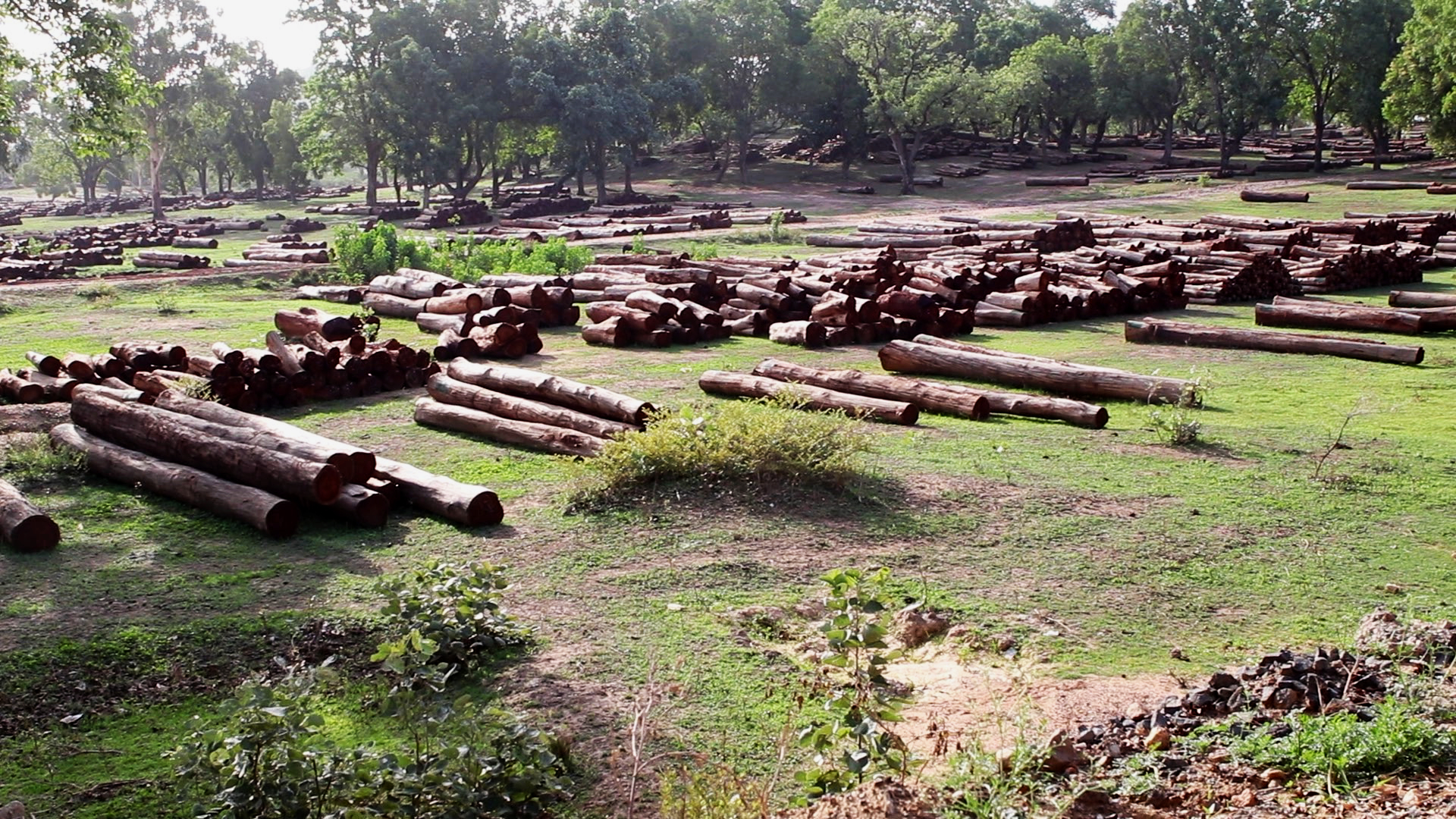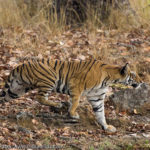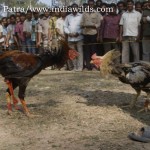IndiaWilds Newsletter Vol. 12 Issue IV
ISSN 2394 – 6946
Re-engineering our life: Back to Nature
Prakriti Rakshati Rakshataha
Nature protects the protectors goes the wise saying by our ancestors. These wise men and women had lived in nature and had keenly observed natures myriad ways and means, deeply understood the patterns and designs of nature, its impact on our lives and the intricate linkage of our life on the natural world.
Even though some of our early texts talk about clearing forests to build new cities, if one dispassionately understands the origin of the texts then one can understand the origins of the train of thought of coexisting with nature and clearing forests (even to a limited extent based on need). The early settlers who had come from the grasslands of the steppes were nature worshippers as noted in the beautiful hymns in the Rig Veda where the forces of nature are eulogised. They were in awe of the forests as well as intimidated and fearful of what kinds of threats the dense forests holds for them. Hence at times clearing up of the forests to create Mahajanapadas or mega cities was seen as a heroic task. When one considers the massive effort needed to cut down trees or break down a hill by means of an axe or hammer or fight with elephant or tiger with just bows and arrows i.e. devoid of all modern equipment, it used to be test of strength. Clearing up forests was also a means to break down the defences of the forest tribes who were resisting the advance of these nomadic races. Hence burning or clearing up of forests are at times seen in the epics like Mahabharata. The forest tribes on the other hand used to worship trees along with worshipping nature Gods like Sun, Moon, wind, thunder, Mountains like Himalaya etc. Nevertheless, there was a sense of dharma in both the nomadic grazers as well as forest living tribes. A sense of right and wrong dictated their actions. Even harming insects was seen as inviting their curse.
Lesson from Mahabharata:
In Mahabharata it is said that Gandhari, wife of King Dhritarashtra and mother of 100 sons was cursed by an ant. Gandhari as a kid had once unknowingly thrown hot water while cooking rice and the hot water had killed the 100 offspring of an ant. The ant then cursed that Gandhari will have 100 kids and all of them will die. In some versions the ant becomes a termite or insect, nevertheless one gets the idea that even unknowingly we are not supposed to harm any species. Whereas a lot of people these days may not attach any importance to it, even today there are sects like Jains who cover their mouths so that unintentionally they won’t ingest flies and harm them.
Bruhad-aaranyaka Upanishad:
Our Upanishads teach us that there is God in everything. In Bruhad-aaranyaka Upanishad, Yajnavalakya on a series of questions by Vidagdha Sakalya first says that there three hundred and three and three thousand and three Gods and then he says “They are but manifestations of them, but there are only thirty three Gods. And when again asked “Katame te trayas trimsad iti?” (Which are these thirty three?), Yajnavalakya says “astau vasavah, ekadasa rudraha, dwadasadityah, te ekatrimsat indraschaiva, prajapatischa trayastrimsav iti” means “The eight Vasus, the eleven Rudras, and the twelve Aadityas, these are thirty one, Indra and Prajapati (makeup) thirty three.”
“Katame vasava iti?” Which are the Vasus?
Yajnavalakya responds, “agnisca prithivi ca, vayus caantariksham caadityas ca dyaus ca chandramas ca nakshatrani ca, ete vasavah, ete su hidam sarvam hitam iti, tasmad vasava iti” means “Fire, the earth, the air, the sky, the Sun, the heaven, the Moon, the stars, these are the Vasus for them in all this is placed: therefore they are called Vasus”
Praaninaam karma-phalasrayatvena karya karana samghata-rupena tan nivaasantvena viparinam anto jagad idam sarvam vaasayanti vasanti ca.
The Vasus transform themselves into bodies and organs of all beings which serve as the support for their work and its fruition as also into their dwelling places. They help other beings to live and they themselves live.
Te yasmaad vaasayanti, tasmad vaasva iti : means because they help others to live they are called Vasus.
Because the Vasus or Gods transform themselves into different beings, people are told “Sarva ghate Narayana” ie. God is there in everybody. So there are traditions, even today in the eastern and in some southern states, of doing Namaste and saying Vishnu when your feet accidentally touches someone else as well as any inanimate object.
Aping the British:
Anything, which was termed as God was deemed as sacred. So people didn’t cut off trees just for the sake of it. Even today, old woodcutters of some tribal communities say that when you need wood and have to cut down a tree then they choose a sick one and cut it. They know that healthy trees will grow whereas a sick one will fall down at the first sign of storm. They ancients knew that they should kill only for their needs. However, the British taught us wanton slaughter of wildlife. In one birdshoot in 1938 in Keoladeo Ghana wildlife sanctuary in Bharatpur, the then Governor General and Viceroy of India Lord Linlithgow shot 4273 birds.
Gradually our cultural values have fallen by the wayside on our relentless quest for a materialistic lifestyle, we are ready to sacrifice other species and our wilderness areas for meeting our narrow short-term vision of creating concrete megacities.
Modern lifestyle not in sync:
We have to realise that living in sync with Mother Earth along with other species is the best lifestyle. Due to our intense hatred for other species we have been eliminating them and hence creating major problems.
In India, though we have lived with snakes for thousands of years, we can’t identify the few poisonous species from the many non-poisonous ones. Snakes feed on the rodents and keep their numbers in control else the rodents have a habit of multiplying exponentially. Similarly having trees nearby and a bit of garden area lying “unmanaged” with bushes ensures that mongoose can live and feed on rodents as well as snakes.
Unfortunately, we have adopted the aesthetics of the British and want lawns. So we clean up the gardens for lawns. And since the native grass doesn’t look great in lawns we import grass. And to keep the grass green we spray pesticides. We forget that lawns take up more water. The water then washes away the pesticides and gets collected in the streams or leach down to poison our earth and any fruits or vegetables grown nearby.
Trees ensure that shikra, kites, eagles can perch on the branches and feed on the rodents and snakes. We cut down large trees because we get annoyed at the leaves falling down as we want that clean look in our garden and roof top. Once the big trees are cut, we lose the shade which used to keep buildings cool. So we rush for air coolers and air conditioners. Similarly more concretisation leads to the air surrounding the buildings heating up and creating a heat island effect leading to desperate installation of ACs in home and hence the spike in energy consumption. The increased demands for energy and water for the metros and other big cities needs dams in rivers. When the flow of a river is stopped, it effectively stops the movement of species in the rivers as well as stops the self-cleansing ability of the river. Perhaps this is why the ancient seers wrote some 3500 years ago in Rig Veda (19th Mantra of 23rd Sukta of 1st Mandala)
“Apsu antah amrutam,
apsu bhaisajam,
apamuta prashastaye,
devah bhavat bajinah”
This loosely translates as “immortality is within the waters, the healing powers are in the waters, O Gods, become full of plentitude (so that) the waters become praiseworthy”.
When entire landscape is converted into concrete jungle, it has impact on the weather pattern. Rainfall decreases due to lack of desiccation from trees. Exposed soil is more prone to erosion leading to desertification. So simple actions by millions of people in unison has lead to the present crisis and onset of climate crisis.
Cornona as trigger for a better world:
As we cross a month of forcibly staying indoors due to the corona virus going rampant and killing more than 2 lakh people worldwide, it is a time to introspect about our wayward ways and think of the best way forward. It is very clear that we can’t be working in the same lackadaisical manner in which we have treated the environment and our natural world.
The metros and other big cities have immense level of pollution. A recent study by Leonardo Setti at University of Bologna in Italy have found corona virus on particulate matters in the air. (SARS-Cov-2 RNA Found on Particulate Matter of Bergamo in Northern Italy: First Preliminary Evidence; doi: https://doi.org/10.1101/2020.04.15.20065995, April 24, 2020). Though this is a preliminary study, given the huge pollutions in Indian cities, we need to be very careful about the health impacts and need to immediately work towards decongesting our big cities. Simply reorganising the transport system into public transport will not work. We have already seen the impact of Odd-Even numbered vehicles plying on the roads on alternate days and have seen that the impact on pollution is very less. And the lockdown induced clear skies with mountain peaks visible from as far as 200kms is a clear sign that we need to have wholesale changes to no only the way we do business but the way we live and exist.
It is abundantly clear that we need to reimagine the way we need to move ahead. And the best thing is we don’t need an extensive re-imagination exercise as we can simply learn from nature and change our lifestyle.
With the advent of internet broadband and the social media, people are more busy in their smartphones and connected with their own groups. They are physically disconnected from their neighbours. They are living in those places simply because of the need to work in big corporates. With the forced work from home situation due to the Corona virus, people as well as companies are now used to this kind of disruption. And corporates now know that these kinds of virus attacks can reoccur in future. When corporates do the necessary tweaking to their security protocols, people can then go back to their native places and work. It is the best way to decongest our cities and large towns and ensure that people can be more connected with nature.
Saving Planet Earth:
The corona virus has forced us to depend on the local stores for our needs. We have local produce and happy with it. However, people in metro towns suffer due to lack of vegetables and fish as most of the things are transported from far off towns. The reduction in air cargo as well as road and rail cargo due to the virus is leading to more reduction of greenhouse gases than the collective resolutions of hundreds of world leaders in United Nations Climate Change conference of parties COP 21.
Man has used his mind to create creature comforts for his sense organs. However, as the God of death Yama has told Nachiketa in the Katha Upanishad:
“Indriyebhyah param mano
Manasah sattvam-uttamam;
Sattvaad-adhi mahaan aatma
Mahatovyaktam –uttamam”
Which means “superior to the sense organs is manas (mind). Superior to manas or mind is buddhi (reason), higher than buddhi is mahat (cosmic mind). And higher than mahat is avyakta (nature in its undifferentiated state).
We have all grown up watching Hollywood movies like Independence Day and believing that all countries in the world can come together and fight a common enemy invading the earth. Today corona virus or Covid-19 is standing as a common enemy of the human race, apart from our own stupidity of course. We hope that the people can convince our leaders to stop pandering to a select few industries and stop decimating our wilderness areas and wildlife.
Travel Article:
Turtle Tales: Arribada in Odisha
Conservation News:
MoEF&CC becomes clearing house of projects during lockdown:
While the country is under lockdown and battling the corona virus, the Ministry of Environment, Forests and Climate Change has shown extreme alacrity in allowing destruction of forests in the name of industrial development.
On 27th March the Ministry has made an amendment to the EIA notification 2006 and has allowed all projects related to bulk drugs and intermediates to be recategorized from existing Category A to B2.
It is to be noted that all projects falling under B2 Category are exempted from the requirement of collection of Base line data, EIA (Environment Impact Assessment) Studies and public consultation. These amounts to blanket approvals. It doesn’t matter how they process their effluents, if at all they process and where they dump it. This will bring untold environmental degradation.
According to the press release the Government claims that “The re-categorization of such proposals has been done to facilitate decentralization of appraisal to State Level so as to fast track the process. This step of the Govt. is with a view to help in increasing the availability of the important medicines/ drugs in the country within short span of time. This amendment is applicable to all proposals received up to 30th September 2020. The states have also been issued advisories to expeditiously process such proposals.
Further, to ensure expeditious disposal of the proposals within given time-line, Ministry has also advised states to use information technology e.g. video conference, considering the fact that in view of the prevailing situation on ground, appraisal of proposals may not be possible through physical meetings.”
As expected, there has been an avalanche of project clearances. Within a period of about two weeks, more than 100 proposals have been received under this category, which are at different levels of decision making by the concerned regulatory authorities in the states.
It is telling that even though the amendment to EIA notification 2006 was done on 27th March, the Ministry decided to do a press release only on 15th of April, 2020.
Given that there has been virtually no political opposition to this Government, they have become blatant in the manner in which they sacrifice our environment and forests for industry.
On 7th of April the standing committee of NWBL chaired by the Minister Shri Prakash Javadekar cleared a host of projects via video conferencing. Unfortunately all the projects striked crucial blows to our various wilderness areas. However, all the minister did was tweet that he approved wildlife clearance for number of developmental projects from 11 states. No details were mentioned in the twitter thread.
I chaired the meeting of Standing Committee of NBWL today through VC and approved wildlife clearance for number of developmental project proposals submitted by 11 States.@PIB_India @MIB_India @moefcc
— Prakash Javadekar (@PrakashJavdekar) April 7, 2020
He mentioned “a multi-purpose project in Uttarakhand to harness water for irrigation and electricity, and irrigation project in Telengana are approved, which will usher in economic & agricultural development of the regions.
A multipurpose project in #Uttarakhand to harness water for irrigation & electricity, and irrigation project in #Telangana are approved, which will usher in economic & agricultural development of the regions.@PIB_India @DDNewslive
— Prakash Javadekar (@PrakashJavdekar) April 7, 2020
However, he didn’t mention that the project in Uttarakhand is the Lakwar Vyasi hydroelectric project where a massive 768 hectares of forest land is diverted. This area is close to Binog wildlife sanctuary.
As we had earlier seen, Himalayas is a comparatively young mountain range and is fragile. The blasting of the mountains for dams and roads is taking its toll. Uttarakhand had its worst landslides in 2013. However all that is forgotten and the Lakwar Vyasi project is cleared. And interestingly this is happening when the cost of solar power has touched Rs. 2.44 per kWH as per 2018 SECI auction. The cost of hydel power works out to around 6 rupees or more. Many projects are not seeing financial completion or being abandoned as the state electricity boards are not lifting high cost power. So it simply defies logic to clear such projects in an ecologically fragile area. And the only two conditions mentioned while clearing this project is construction of speed breakers and no night traffic. So clearly the ministry has decided that environment and wildlife doesn’t matter.
Advisory regarding containing and management of COVID-19 in National Parks/ Sanctuaries / Tiger Reserves:
In view of the spread of COVID 19 in the country and a recent news report on a Tiger being infected with the COVID 19 in New York, the Ministry of Environment, Forest and Climate Change has issued an advisory regarding containing and management of COVID-19 in National Parks/Sanctuaries/Tiger Reserves as it is felt that there are possibilities of spread of the corona virus amongst animals in National Parks/Sanctuaries/Tiger Reserves and also transmission of the virus from humans to animals and vice-versa. In some parks like Bandhavgarh and Ranthambhore, at times tigers move very close to the vehicles. So the chances of human to tiger transmission of virus is a possibility.
The advisory has asked Chief Wildlife Wardens of all States/UT’s to:
- Take immediate preventive measures to stop the transmission and spread of the virus from humans to animals and vice versa, in National Parks/Sanctuaries/Tiger Reserves.
- Reduce the human wildlife interface.
- Restrict the movement of people to National Parks/Sanctuaries/Tiger Reserves.
- Constitute a Task Force/Rapid Action Force with Field Managers, Veterinary doctors, Frontline staff, to manage the situation as quickly as possible.
- Create a ‘round the clock’ reporting mechanism with a Nodal Officer for swift management of any cases noticed.
- Set up essential services for emergency treatment of animals and their safe release back to their natural habitats, as and when required.
- Enhance disease surveillance, mapping and monitoring system through coordinated effort amongst various Departments.
- Maintain all other stipulations issued by the Health Ministry in the movement of staff/tourists/villagers, etc. in and around National Parks/Sanctuaries/Tiger Reserves.
- Take other possible steps to control the spread of the virus.
- Report the action taken to this Ministry.
Many people are dependent on tourism. The hotels, tour operators, guides, drivers etc were hoping that atleast a month of the summer season can be salvaged. However, the number of Corona virus deaths is increasing and several states have demanded the lockdown to be extended atleast till end of May. Some of the National Parks are closed for monsoon. It appears that all the parks may open during October if the corona cases continue for the next month or two.
The wildlife safaris in India are cramped. People are pushed into cramped vehicles where legroom is often less than the low cost airlines. Tourists who are unknown to each other would definitely not like to be pushed into such cramped vehicles, especially since there is no vaccine developed for Corona virus and the virus is still active. So the tourism sector cannot run the way it was running till early this year before corona virus ensured all activities were stopped.
The forest departments are also greedy and allow many tourist vehicles which leads to over crowding. That has to stop. It is to be seen if the forest department does any changes post Covid-19 opening of forests.
Equipment Discussions:
Canon announces C300 Mark III Cinema camera:
Canon has announced the C300 Mark III cinema camera with S-35 sensor.
DJI has launched the Mavic Air 2 quadcopter
Canon announces Final Specs of 8K EOS R5 mirrorless camera
Canon has finally announced the complete specifications of its EOS R5 camera which promises to be revolutionising the filming industry since the original EOS 5D Mark II did.
The Canon EOS R5 mirrorless camera is named R5 as it has the RF mount and is denoting that it is equivalent to the 5D of the SLR cameras. Canon had introduced the EOS R full frame mirrorless system in 2018 and has been making constant efforts to ensure that this becomes a premium system with high quality lenses. Canon says that the specs of the EOS R5 camera is a result of major improvements to its imaging technology as well as new RF lenses specifically built to give massive improvements. With Canon ensuring 8K video upto 30p in the EOS R5 mirrorless camera, this is expected to be a gamechanger.
Now it is upto to the photographers and filmmakers to elevate your creativity to the next level using this camera.
Advanced Full-Frame CMOS Sensor
Canon has developed an entirely new CMOS image sensor for the EOS R5. Canon promises that the distinguishing feature of this camera is its image quality due to the newly developed CMOS sensor and new DIGIC processor.
High Speed still shooting upto 20fps
The EOS R5 can capture still photos of fast moving subjects in high speed burst. At up to 12fps with mechanical shutter and up to 20fps with silent shutter, the EOS R5 can capture the split-second details between a subject’s movement.
Astonishing Autofocus and Subject detection
The EOS R5 brings subject detection to a new level – Utilizing Canon’s Dual Pixel CMOS AF Technology, the EOS R5 will be capable of making Ultra-High-Speed Autofocus calculations to match its immensely powerful High-Speed Shooting capability of 20 fps. Subject detection adopted from the Live View AF tracking system in the EOS-1D X Mark III brings Face, Head and even Eye tracking when People detection is set, providing ease and accuracy when capturing stills or video. Detection of Animals will also be possible for the first time in a Canon camera, effectively tracking the whole body, face, or eye of cats, dogs, or birds for speed and precision.
8K video
Canon EOS R5 can shoot and record internally uncropped 8K video shooting at up to 29.97fps, and 4K video shooting at up to 119.9fps, in 4:2:2 10-bit (H.265) Canon Log. Dual Pixel CMOS AF is available in all 8K and 4K modes so we will not struggle with focussing while shooting high resolution video in slow motion.
One can also shoot and Internally record uncropped 8K RAW Recording up to 29.97 fps with Dual Pixel CMOS AF, and HDR-PQ Recording (H.265) capability.
Dual Card Slots
The EOS R5 has one super high-speed CFexpress card slot plus for 8K video as well as a UHS-II SD card slot. It would have been better to have both CFexpress slots, however, Canon perhaps thought that having a UHS-II SD slot will be better for people who don’t shoot video. For Video shooters who want to use the 8K video, this is a compromise. Many professional shooters will be troubled that there is only one CFexpress slot.
In body stabilisation
The EOS R5 is Canon’s first camera to incorporate 5-axis IBIS (In-Body Image Stabilization). This will help while shooting stills in slow shutter speed as well as help in reducing shake while recording movies. The EOS R5’s IBIS will work in combination with Optical Image Stabilization found in many Canon RF and EF lenses.
Uploading to Cloud:
With the creative process being just as important as image capture, the EOS R5 will support automatic transfer of still image and video files from the device to the new image.canon cloud platform. New workflows will be possible through the automatic download and backup of data to your Mac/PC, or automatic transfer of data to external services such as Google Drive and Flickr*. *Starting in June, image.canon will expand both of its partnerships with Google to include original quality backup with Google Photos™ via Google One™, a membership plan for expanded storage, as well as Adobe® Creative Cloud® (membership plan). Event shooters can easily take the benefit of this option.
Price: Canon hasn’t announced the price till date.
Canon introduces Cine-servo 25-250mm T2.95-3.95 cinema lens
Canon introduces Cine servo 25-250 mm T2.95-3.95 cinema lens
Natural History
COUNTRY NOTEBOOK: M. Krishnan: ‘The Cat that almost was‘ shared By Saktipada Panigrahi
https://www.indiawilds.com/forums/showthread.php?8852-Country-notebook-m-krishnan&p=89010#post89010
Wildlife Photography
Irrawaddy Dolphin by Mrudul Godbole
https://www.indiawilds.com/forums/showthread.php?19526-Irrawaddy-dolphin
Indian Fox Pups by Vipin Sharma
https://www.indiawilds.com/forums/showthread.php?19548-LRK-diary-March-2020
Tiger cub by Sucheth Lingachar
https://www.indiawilds.com/forums/showthread.php?19542-The-Cute-Cub
Tigress by Shyamala Kumar
https://www.indiawilds.com/forums/showthread.php?19532-The-climb-up-from-the-Ravine
Crested-Serpent-Eagle in Sundarbans by Saktipada Panigrahi
https://www.indiawilds.com/forums/showthread.php?19531-Sundarbans-Jan-2020-Crested-Serpent-Eagle
Peregrine Falcon by Sabyasachi Patra
https://www.indiawilds.com/forums/showthread.php?19525-Exploring-Sundarbans-Peregrine-Falcon
Nature’s Own Canvas by Sandipan Ghosh
https://www.indiawilds.com/forums/showthread.php?19535-Nature-s-Own-Canvas
Grey Heron with Snake by Mrudul Godbole
https://www.indiawilds.com/forums/showthread.php?19544-Grey-Heron-with-Snake-Stay-Safe
The Flying Lizard by Jerin Dinesh
https://www.indiawilds.com/forums/showthread.php?19552-The-Flying-lizard
Parasitoid wasp by Prajwal Ullal
https://www.indiawilds.com/forums/showthread.php?19538-My-precious!!!
This is the 136th issue of IndiaWilds. The photo of an adolescent tiger staring at the water from a check dam adorns this issue. Tiger cubs and adolescents are curious by nature. They stop to investigate anything and everything that catches their attention. They start hunting by catching small prey including frogs. In this image we don’t know why the tiger is so intently looking at the water. Is it for food or is it trying to do some cyrstal gazing wondering what its future looks like? Given that tiger is revered as Goddesses Durga’s vehicle, it would know what is happening in various parts of India. In such case, the tiger would be really worried as every now and then the Government gives away tiger habitat to industries and for construction of dams and other projects. The forest corridors connecting various wildlife sanctuaries and National Parks have been destroyed. So it becomes very difficult for tigers to move from one area to another in search of suitable territory. The result is loss in genetic diversity. And when there is an outbreak of infectious disease, the lack of genetic diversity ensures that tigers in a particular area become more susceptible to the disease.
Tiger is not just a symbol of power and grace. Tiger as the apex predator also acts as a bellweather of the health of the landscape it lives in. To save the tiger we have to save the forests it lives in, and numerous other species get saved in the process. The rivers and streams originating from those forests too get saved. And we too can get saved from the vagaries of climate change. Forests are also repositories of our biodiversity and natural wealth. We are yet to unravel the various mysteries of nature and benefit from those. The sooner we learn that human life is intricately linked with the health of our ecosystems, the better will be the chances of longterm survival of human race.
I look forward to your inputs and support in preserving the last tracts of wilderness and wildlife left in our beautiful country and raising awareness about it. For other interesting articles and images check –
http://www.indi
To post in the IndiaWilds forums, you can register free of cost using your Full Name as user id at:
http://www.indiawilds.com/forums/register.php
If you are already a member of IndiaWilds and have forgotten your user id and/or password you can mail to:
administrator@indiawilds.com
If you want to contribute original articles, or for any image enquiries please send a mail to:
administrator@indiawilds.com
Regards,
Sabyasachi Patra
Profile | Contact Us | Facebook | Diary | Equipment reviews | Forums | IndiaWilds You Tube Channel
Please post your views and feedback in the comments below.
- GoPro Hero 12 Black - 6 September,2023
- Leopards: The Last Stand - 2 July,2023
- Drifting in the Waters of Sundarbans - 26 March,2023















Leave a Reply